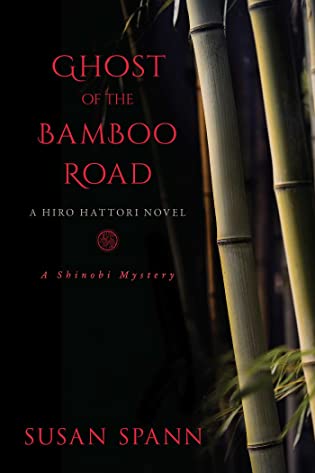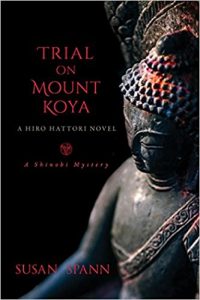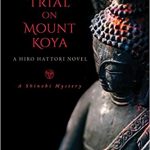 Ghost of the Bamboo Road: A Hiro Hattori Novel by Susan Spann
Ghost of the Bamboo Road: A Hiro Hattori Novel by Susan Spann Format: ebook
Source: purchased from Amazon
Formats available: paperback, ebook
Genres: historical fiction, historical mystery, mystery
Series: Shinobi Mystery #7
Pages: 272
Published by Seventh Street Books on November 12, 2019
Purchasing Info: Author's Website, Publisher's Website, Amazon, Barnes & Noble, Kobo, Bookshop.org
Goodreads
When a vengeful spirit terrorizes a mountain village, a ninja and a Jesuit must save the villagers from the phantom’s wrath.
January 1566: En route to Edo, Master ninja Hiro Hattori and Portuguese Jesuit Father Mateo spend the night in a rural mountain village whose inhabitants live in terror of a legendary vengeful ghost. When the innkeeper's wife is murdered and Father Mateo’s housekeeper, Ana, is blamed for a crime she did not commit, Hiro and Father Mateo are forced to investigate and reveal the truth. But when another woman turns up murdered in the snow, the detectives must face the shocking truth that the vengeful yurei the villagers fear might be more than just a legend after all.
My Review:
 No one wants to think that one of their neighbors is capable of committing murder – or even any lesser crimes. It’s why so many small town and country house mysteries usually start out with everyone involved pointing the finger, not at each other, but at some unknown wandering stranger. We all want our own little closed group to be blameless – it’s too uncomfortable to think otherwise.
No one wants to think that one of their neighbors is capable of committing murder – or even any lesser crimes. It’s why so many small town and country house mysteries usually start out with everyone involved pointing the finger, not at each other, but at some unknown wandering stranger. We all want our own little closed group to be blameless – it’s too uncomfortable to think otherwise.
But for the blame for not one or two but eventually four recent deaths in an isolated rural village to be attributed to ghosts and not any living humans at all is a bit too much for either shinobi (read ninja) Hiro Hattori and his friend and protectee Father Mateo to credit. The villagers may believe in ghosts, but Hiro has too much practical experience of the world to believe in ghosts. Father Mateo’s faith means that he does not believe in ghosts either – no matter how many times one of the villagers claims that he already is one.
Both Hiro and Father Mateo also have way too much experience in investigating mysterious and uncanny murders that always turn out to have been committed by humans and not any supernatural creatures at all.
Color them both skeptics. Even in the face of seemingly an entire village quivering in fear of an avenging ghost who seems to be systematically eliminating every remaining villager who refused to help her when she was alive.
It’s too easy for the logical Hiro to see that while the deaths may be mysterious, placing the blame on a ghost is a bit too convenient for someone. Or perhaps more than one someone. But the inconvenience of the local samurai refusing to allow them to leave until the crime is solved is all too real – and his blackmail attempt all too transparent.
 It’s up to Hiro to suss out the real killer and their real motives – along with discovering who is responsible for a string of thefts that is somehow tied up in the murders – before they can continue on their self-appointed journey to Edo.
It’s up to Hiro to suss out the real killer and their real motives – along with discovering who is responsible for a string of thefts that is somehow tied up in the murders – before they can continue on their self-appointed journey to Edo.
Escape Rating A-: I was so tempted to start with a Ghostbusters riff, because neither Hiro nor Mateo are afraid of any ghosts. Making this story an attempt to tell a ghost story with two total non-believers at its center.
The journey that Hiro and Mateo are on, from the disaster at Mount Koya in the previous book in the series, Trial on Mount Koya, is self-appointed or self-inflicted on Hiro’s part. The organization and family that trained him in the hidden arts of the shinobi is under threat from the capital, and Hiro is trying to warn all the covert agents along the way to Edo. Father Mateo is on the run after the events in a previous book in the series, The Ninja’s Daughter.
That being said, this story does stand somewhat alone. Not that knowledge of the previous events in the series isn’t handy or that acquiring that knowledge by starting at the beginning in Claws of the Cat isn’t a great reading time, but it would be possible to pick this up without starting at the beginning as this is set in an isolated part of their longer journey.
However, this series as a whole is an absolute treat for historical mystery and historical fiction readers. At the time the story takes place, Medieval Japan was mostly closed to outsiders. Father Mateo’s presence as guide and audience surrogate provides a window into a time, place and culture that was just opening to outsiders. We have been able to explore and discover along with him, while helping – or sometimes hindering – Hiro’s investigations along the way.
And while watching their relationship, initially curious strangers, bodyguard and protectee, change into friendship verging on brotherhood – with all the affection and exasperation inherent in that kind of family tie.
The case they have to solve here is both fascinating because of its setting and familiar because of the all-too-human motivations that set these crimes into motion. Hiro and Mateo are always outsiders even in places where they are most familiar, but in this tiny village they are more obviously so. It’s clear that much is known but not spoken of, and it’s up to these two strangers to bring those secrets into the light of day.
 If only so that they can finally escape the place with their own mission also accomplished and their household intact!
If only so that they can finally escape the place with their own mission also accomplished and their household intact!
I’ve followed this entire series, and loved every minute of it. But somehow I missed this book when it came out, and didn’t discover it existed until I learned about the upcoming publication of the next book in the series, Fires of Edo, which is due out in mid-February. From the title, it looks like their rather fraught journey to Edo is going to reach its destination, but hopefully not its end.
I’m looking forward to traveling with them again. Soon!




















One thought on “Review: Ghost of the Bamboo Road by Susan Spann”
Comments are closed.